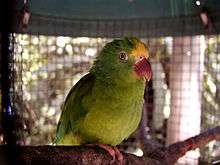Brotogeris
| Brotogeris | |
|---|---|
4.jpg) | |
| Plain parakeet | |
| Scientific classification | |
| Kingdom: | Animalia |
| Phylum: | Chordata |
| Class: | Aves |
| Order: | Psittaciformes |
| Superfamily: | Psittacoidea |
| Family: | Psittacidae |
| Subfamily: | Arinae |
| Genus: | Brotogeris Vigors, 1825 |
| Species | |
|
see text | |
Brotogeris is a genus of small parrots endemic to Central and South America. The closest relative is the monk parakeet.[1][2][3][4] They eat seeds and fruit.[5]
Taxonomy
List of species of the genus:
- Plain parakeet, Brotogeris tirica
- White-winged parakeet, Brotogeris versicolurus
- Yellow-chevroned parakeet, Brotogeris chiriri (also called canary-winged parakeet)
- Tui parakeet, Brotogeris sanctithomae
- Grey-cheeked parakeet, Brotogeris pyrrhoptera
- Orange-chinned parakeet, Brotogeris jugularis (also called Tovi parakeet)[5]
- Cobalt-winged parakeet, Brotogeris cyanoptera
- Golden-winged parakeet, Brotogeris chrysoptera
Phylogeny
The species of the genus Brotogeris form a monophyletic group[4] whose closest relative is the monk parakeet.[1][2][3][4] The species are positioned in two separate clades.
| |||||||||||||||||||||||||||||||||||||||||||
| | |||||||||||||||||||||||||||||||||||||||||||
| |
Species photographs
-
_-on_branch.jpg)
Plain parakeet
(Brotogeris tirica) -
_captivity.jpg)
Grey-cheeked parakeet
(Brotogeris pyrrhoptera) -

Yellow-chevroned parakeet
(Brotogeris chiriri) -
10c1.jpg)
Orange-chinned parakeet
(Brotogeris jugularis) -

Cobalt-winged parakeet
(Brotogeris cyanoptera) -

Tui parakeet
(Brotogeris sanctithomae)
References
- 1 2 Tavares, E.S.; Baker, A.J.; Pereira, S.L.; Miyaki, C.Y. (2006). "Phylogenetic relationships and historical biogeography of Neotropical parrots (Psittaciformes: Psittacidae: Arini) inferred from mitochondrial and nuclear DNA sequences". Systematic Biology 55 (3): 454–470. doi:10.1080/10635150600697390. PMID 16861209.
- 1 2 Ribas, C.C.; Moyle, R.G.; Miyaki, C.Y.; Cracraft, J. (2007a). "The assembly of montane biotas: linking Andean tectonics and climatic oscillations to independent regimes of diversification in Pionus parrots". Proceedings of the Royal Society B: Biological Sciences 274 (1624): 2399–2408. doi:10.1098/rspb.2007.0613.
- 1 2 Wright, T.F.; Schirtzinger E. E.; Matsumoto T.; Eberhard J. R.; Graves G. R.; Sanchez J. J.; Capelli S.; Muller H.; Scharpegge J.; Chambers G. K.; Fleischer R. C. (2008). "A Multilocus Molecular Phylogeny of the Parrots (Psittaciformes): Support for a Gondwanan Origin during the Cretaceous". Mol Biol Evol 25 (10): 2141–2156. doi:10.1093/molbev/msn160. PMC 2727385. PMID 18653733.
- 1 2 3 Ribas, C. C.; Miyaki, C. Y.; Cracraft, J. (2009). "Phylogenetic relationships, diversification and biogeography in Neotropical Brotogeris parakeets". Journal of Biogeography 36 (9): 1712–1729. doi:10.1111/j.1365-2699.2009.02131.x.
- 1 2 Alderton, David (2003). The Ultimate Encyclopedia of Caged and Aviary Birds. London, England: Hermes House. p. 196. ISBN 1-84309-164-X.
This article is issued from Wikipedia - version of the Sunday, July 05, 2015. The text is available under the Creative Commons Attribution/Share Alike but additional terms may apply for the media files.